
Epcos has developed ceramic components that combine EMI and ESD protection with additional filter functions in a miniature 0405 case. As well as the familiar single-resonance components, EMI filters in dual-band, wideband or low-pass design are now available.
Many improvements and innovations in electronics have gone hand in hand with increases in signal frequencies and bit rates. Here, suppression of high-frequency noise signals is an important design issue that calls for new components. These should not only filter out noise components and associated harmonics, but must also be suitable for the latest packing densities on PCBs. Integrated components help to minimise component count.
New developments
These design aims can now be reached thanks to two new developments by Epcos. The first is a recently-patented electrode design that suppresses crosstalk between the layers of a multilayer ceramic capacitor (MLCC) in case size 0405. Significantly higher series resonant frequencies can thus be obtained since the equivalent series inductance (ESL) is extremely low. ESL is reduced because the ground contact inductance of the two symmetrical ground pads is connected in parallel and the inductance of the signal connection is in series with the signal and not with the capacitor. The second innovation is a pi-filter structure (Figure 1) that has been fully integrated into a chip of size 0405 (1 x 1,37 mm). Two varistors for ESD protection are also accommodated on the chip.
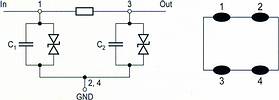
For detailed tests, the following sample types were used: multilayer ceramic capacitors COG/0603/120 pF, HQM/0603/110 pF, X7R/0603/100 pF and multilayer varistor MLV/0603/14 V/120 pF.
The insertion losses of various MLCCs and MLVs, measured close to their resonant frequencies, are compared in Figure 2 to Figure 5. Variation of the resistance of the MLV with frequency (Figure 5) is similar to that of a COG material with high insertion loss. The highest insertion loss is found in material HQM due to the extremely low equivalent series resistance (ESR). In contrast, the conventional X7R material has a significantly lower insertion loss.
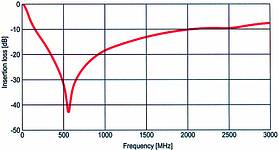
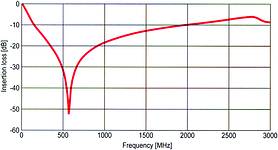
The outstanding EMI suppression of the HQM MLCCs and HQM MLV is particularly well illustrated in Figures 2, 3, and 5. The resonant frequency can be modified simply by changing the number of internal electrodes. This is important for special applications such as suppression of GSM carrier frequencies.
The comparison in Figure 6 demonstrates that feedthrough capacitors operate across a wider frequency range than SMD capacitors of the same chip size commonly used up till now. The upper test curve shows that the resonant frequency of a capacitor of size 1206 and rated at 2,2 nF shifts from 120 to 280 MHz.
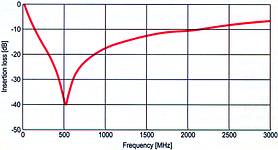
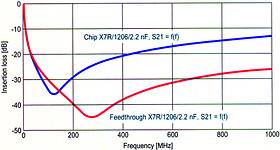
The insertion loss of a crosstalk configuration in a 50 Ω system is greater than 40 dB at the resonant frequency. To measure the arrangement with two capacitors of size 0405 and material COG shown in Figure 7, the two capacitors (22 and 47 pF) were connected in parallel.
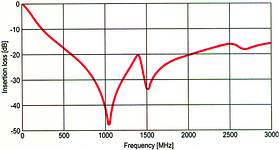
Here, the lower capacitance (22 pF) causes the second resonance. The insertion loss for this type of configuration is always lower than at the first resonance peak. Two sharp resonance peaks with an insertion loss greater than 40 dB (Figure 8) can be obtained with an integrated crosstalk configuration.
This was implemented in the dual-band crosstalk filter of size 0405 (same design with integrated MLV). This miniaturised crosstalk filter can be used to suppress two specific frequencies. One example is the suppression of undesired noise components in the two carrier frequencies of dual-band mobile phones. If all four capacitors of size 0508 in the quad configuration are connected in parallel, an insertion loss characteristic as shown in Figure 9 is obtained.
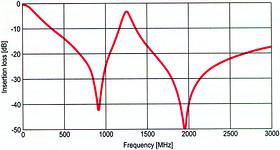
The significant rise in insertion loss at both resonant frequencies is caused by connection of at least three capacitors in parallel, even if this arrangement is not a crosstalk configuration. This characteristic is obtained from connection of the ESR of each capacitor in parallel. A pi-type filter is created when an additional series resistor is integrated into the dual-band crosstalk filter structure. This pi-type filter is distinguished by a broadband EMI filter characteristic. Thanks to this combination and an additional varistor, excellent ESD protection is achieved as well. The insertion loss characteristic of an MLV pi-filter is depicted in Figure 10.
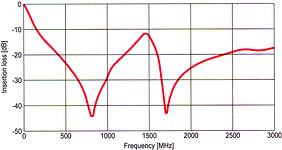
This broadband filter function with an insertion loss better than 20 dB can be used in a frequency range from 700 MHz to 2,58 GHz. Harmonic noise components with high levels, as occur in PDAs, video equipment and tri-band mobile phones, are thus suppressed.
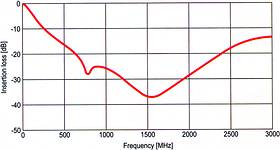
Summary
Used in suitable variations and combinations, multilayer ceramic capacitors and varistors can offer combined EMI and ESD protection together with specified filter characteristics. Factors such as the choice of ceramic material (HQM, COG or X7R), which is decisive for insertion loss, have to be taken into account. Filter characteristics that perfectly match the application can be obtained by connecting the components in series and/or parallel. These multilayer ceramic components from Epcos offer the following advantages:
* Small SMDs from size 0405 upward.
* Application-specific filter characteristics can be obtained by connecting dual and quad components.
* Component count reduced further, thanks to integration of multilayer varistors.
| Tel: | +27 11 458 9000 |
| Fax: | +27 11 458 9034/5 |
| Email: | [email protected] |
| www: | www.electrocomp.co.za |
| Articles: | More information and articles about Electrocomp |
© Technews Publishing (Pty) Ltd | All Rights Reserved